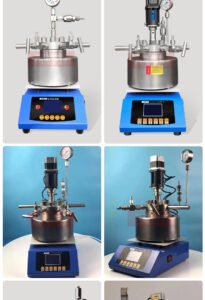A Trusted Component in High-Pressure Chemical Synthesis
In modern chemical synthesis, controlled high-pressure and high-temperature environments are essential for advancing research in materials science, nanotechnology, and organic chemistry. The 304/316 stainless steel hydrothermal vessel has emerged as a critical tool for executing such complex reactions. Offered by Equilrxnlab, this synthesis vessel integrates material reliability with precision engineering, making it an indispensable part of research laboratories worldwide.
Material Integrity and Resistance in Harsh Chemical Conditions
Hydrothermal synthesis often involves corrosive reagents and elevated thermal stress. To withstand these conditions, Equilrxnlab manufactures vessels from 304 or 316 stainless steel, offering a robust structural foundation. The 304 variant provides excellent corrosion resistance under atmospheric conditions, while 316 stainless steel contains added molybdenum, offering enhanced protection in chloride-rich or acidic environments. This distinction empowers researchers to select a vessel that aligns with their experimental needs.
The vessel’s internal liner, made from PTFE (polytetrafluoroethylene), enhances chemical inertness and thermal stability. This dual-layer design ensures the containment of reactive species while maintaining structural durability.
Technical Parameters Overview
- Volume Options: 5 ml to 500 ml
- Body Material: 304 Stainless Steel
- Liner Material: PTFE
- Support Rod: Optional (8×200 mm or None)
- Sealing Mechanism: Screw cap with manual clamp
- Max Temperature: ≤220°C
- Max Pressure: ≤3 MPa
View complete specifications at the product page.
Applications in Hydrothermal and Solvothermal Synthesis
Hydrothermal vessels are pivotal in the synthesis of advanced functional materials. Common applications include:
- Nanomaterial fabrication: Formation of ZnO, TiO₂, and other metal oxide nanoparticles.
- Crystal growth: Facilitates the growth of single crystals under autogenous pressure.
- Coordination complexes: Enables the formation of coordination polymers and metal-organic frameworks (MOFs).
- Layered compound synthesis: Applied in synthesizing lamellar structures such as clays or intercalated compounds.
Because of its tolerance to high pressure and temperature, the 304/316 stainless steel hydrothermal vessel enables homogeneous nucleation, precise particle size control, and enhanced yield.
Engineering Considerations and Safety Design
The vessel incorporates a manual clamping mechanism to secure the PTFE-lined chamber tightly. This design ensures a uniform pressure seal under dynamic thermal conditions without relying on external fasteners or automated systems.
Equilrxnlab also emphasizes operator safety and temperature stability by suggesting an ambient working environment of 5°C–35°C with ventilation humidity levels between 60% and 80%. Temperature precision is reinforced through structural insulation and consistent material properties.
Selecting the Right Hydrothermal Vessel: 304 vs. 316 Stainless Steel
While both types offer commendable resistance and strength, 316 stainless steel is preferred for environments where chloride-induced corrosion is a concern—such as marine or saline-based solvent systems.
- Choose 304 Stainless Steel when working with basic solutions or neutral pH conditions.
- Choose 316 Stainless Steel when working with acidic solutions, particularly halogen-containing systems.
This customizable selection reflects Equilrxnlab’s commitment to addressing variable laboratory conditions with technical flexibility.
The Role of Equilrxnlab in Research Equipment Innovation
Equilrxnlab is known for designing and delivering laboratory-scale thermal control and reaction systems. In addition to hydrothermal vessels, its catalog includes:
Their extensive product catalog outlines various models and configurations, offering researchers an intuitive platform to match equipment with experimental protocols.
Maintaining System Performance in Long-Term Use
To ensure continued accuracy and safety in hydrothermal synthesis, Equilrxnlab recommends the following best practices:
- Pre-cleaning the PTFE liner before each use to prevent cross-contamination.
- Avoiding rapid temperature changes that can lead to stress fractures in PTFE.
- Monitoring pressure and temperature limits using calibrated external sensors.
- Ensuring uniform heating with compatible circulators or mantle systems.
Users may also refer to technical guides and support documentation accessible via Equilrxnlab’s contact page.
Global Accessibility and Community Engagement
Equilrxnlab maintains a vibrant international community of researchers and equipment users. Their social platforms feature tutorials, case studies, and updates on laboratory innovation.
- YouTube: Watch setup walkthroughs and demonstrations.
- Instagram: Visual insights from lab setups and product integration.
- Facebook: Discussions, product launches, and technical highlights.
By offering education and engagement alongside product functionality, Equilrxnlab ensures continuous support for research laboratories around the globe.
Future Outlook: Expanding Applications in Emerging Research Fields
As materials science and green chemistry evolve, the 304/316 stainless steel hydrothermal vessel is increasingly relevant in developing biodegradable polymers, energy storage systems, and pharmaceutical intermediates. Its ability to maintain thermal equilibrium under intense conditions positions it as a foundational tool in experiments requiring reproducibility and purity.
The adaptability of these vessels also promotes their use in academic and industrial settings. From undergraduate laboratories to industrial R&D hubs, the versatile size range (5 mL to 500 mL) supports both small-scale exploratory reactions and larger batch synthesis.
Explore available volumes and specifications directly through the Equilrxnlab product page or consult their contact form for technical assistance and custom orders.
By integrating advanced material science with user-oriented design, Equilrxnlab’s 304/316 stainless steel hydrothermal vessel continues to play a critical role in transforming experimental chemistry into reproducible outcomes.




